By the time most California Condors mature to reproductive age at about six years, they have encountered a wealth of dangers in the wild. Surviving predators, accidents, and toxins is no guarantee of breeding success though—condors’ first nesting attempts often fail before the chick is old enough to leave its nest cave, and chicks that do fledge depend on their parents for a year or more.
California Condors would almost certainly be extinct if not for breeding programs, which started in the 1980s with the last 22 condors removed from the wild. The Peregrine Fund was invited by the U.S. Fish and Wildlife Service to breed condors at its World Center for Birds of Prey in Boise, Idaho, beginning in 1993. We work closely with partners coordinated by the U.S. Fish and Wildlife Service, including the three zoos that breed condors (Los Angeles, San Diego, and Oregon). Together we set annual goals for the number of condors to be produced, and designate where the previous year’s chicks should be released.

Phillip McClain

By controlling risks like predators, accidents, and food contamination, we enable our captive breeders to consistently achieve success rates above 90 percent. More than half of all California Condors raised in breeding programs, 16–20 young each year, come from our facility in Boise and are divided among several release sites, including the one we manage near the Grand Canyon.
Our propagation specialists are experienced field biologists with a keen awareness of condor behavior and social structure. They create conditions that not only keep condor parents secure and content, but also prepare the young hatchlings to become wild survivors.
Because condors are highly intelligent and curious, they can rapidly learn to associate humans with food rewards. This can spell disaster for a condor, especially one destined to fly free near a high-tourist area like the Grand Canyon. To keep our young condors from becoming familiar with humans, we design their enclosures so they rarely see or hear people. We even employ a small herd of goats to clear nearby brush rather than using mowers!
Thanks to the success of condor breeding programs, four of the original 22 are so well-represented in the wild population’s genetics that they are no longer needed for breeding. Those hardy, long-lived birds returned to the wild homes they inhabited forty years ago to live their remaining years with hundreds of free-flying descendants—no longer the “last” of their kind.







